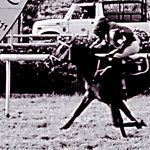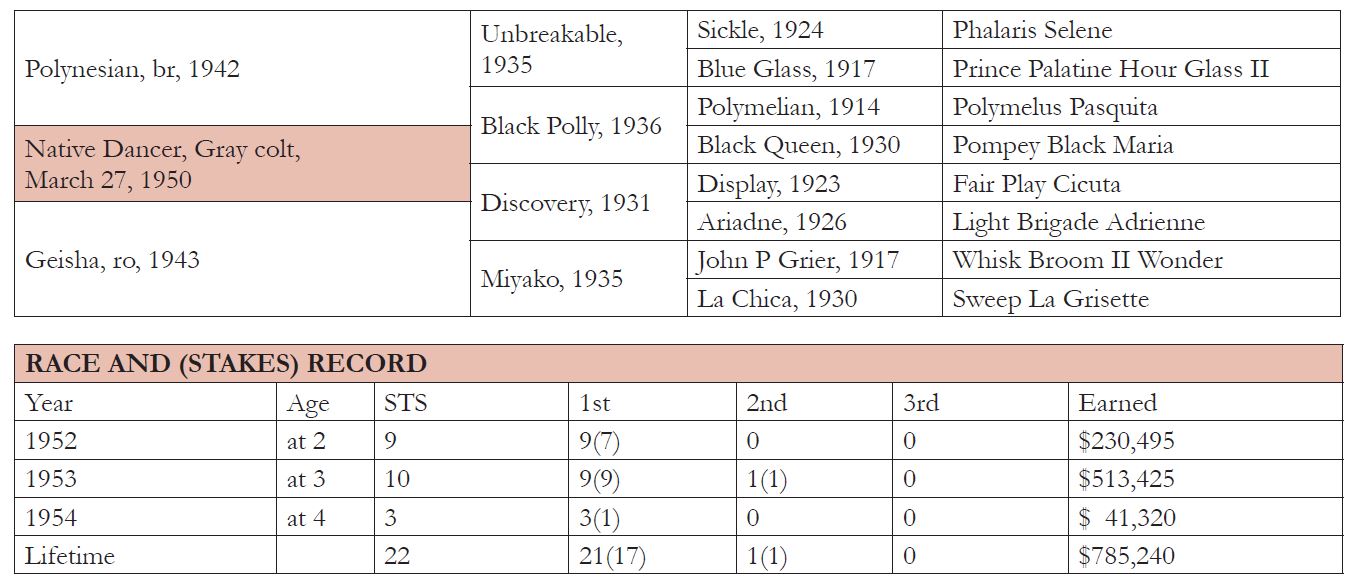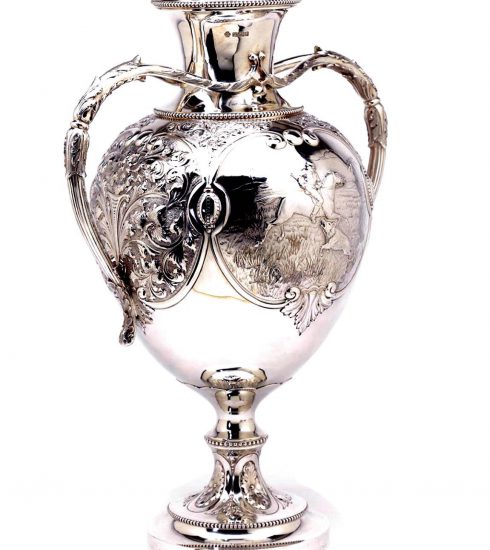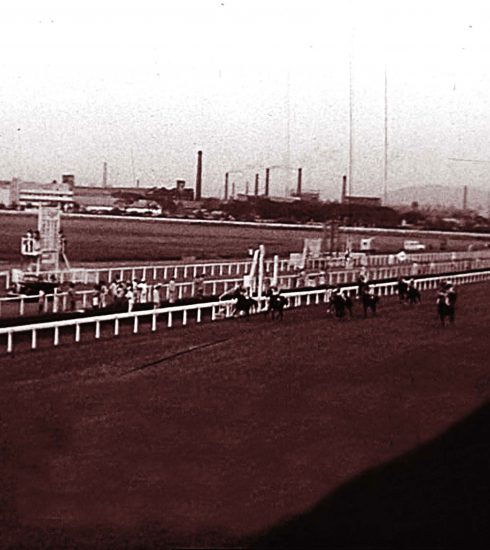Native Dancer
 [dropcap]T[/dropcap]he 1953 Kentucky Derby held great anticipation, much of it centered around Alfred Vanderbilt’s big gray colt, Native Dancer. Undefeated in eleven races previous to the season’s first classic, Native Dancer had been the 1952 champion two-year-old male after winning all nine starts.
[dropcap]T[/dropcap]he 1953 Kentucky Derby held great anticipation, much of it centered around Alfred Vanderbilt’s big gray colt, Native Dancer. Undefeated in eleven races previous to the season’s first classic, Native Dancer had been the 1952 champion two-year-old male after winning all nine starts.
Coupled with Social Outcast as a 2-3 favoured entry, Native Dancer was widely expected to emerge from the Derby with his unblemished record intact. But as the race unfolded, the worst fears of trainer Bill Winfrey and jockey Eric Guerin materialized. Rounding the first turn, Native Dancer was bumped soundly by longshot Money Broker. The colt recovered and began to move on the leaders, Dark Star and Correspondent. Once clear of traffic, Native Dancer began his pursuit of Dark Star that many believed would have a predictable result: another win for the “Gray Ghost.” But at the wire, Native Dancer’s run came up a head shot.
Not only did the Derby outcome end one of the racing’s best winning streaks, it was also a bitter defeat for the thousands of Americans who had embraced the colt. “When he lost the Kentucky Derby by a head, thousands turned from their TV screens in sorrow, a few in tears,” Time magazine later reported in a cover story about Native Dancer and his popularity. “Hundreds of people, old and young, have sent him letters and greeting cards. Little girls have organized fan clubs in his name.”
In his first outing after the stunning Derby loss, Native Dancer began another winning streak that ended ten races and fifteen months later when he was retired. Native Dancer’s final tally sheet of twenty-one victories from twenty-two starts stands as one of the all-time best and placed him in elite company with Man o’ War, Secretariat, and Citation. Not unlike those stars, Native Dancer also became a household name across the country as his exploits were chronicled on television, the new medium that was becoming increasingly popular in the early 1950’s.
A son of Polynesian, Native Dancer was foaled March 27, 1950, at Dan W Scott’s, Scott Farm near Lexington, Kenkucky, and sent to his owner’s Sagamore Farm in Maryland not long afterwards. Winner of the 1945 Preakness Stakes, Polynesian was known for his quickness. On the male side, Native Dancer traced back to Phalaris, one of the most successful male lines in American breeding. Geisha, the gray dam of Native Dancer, was a daughter of Discovery, among Vanderbilt’s best horses before the “Gray Ghost.” Through Discovery, Geisha traced back to Fair Play, the sire of Man o’ War and a source of stamina.
Prepped at Santa Anita for his racing career, Native Dancer caught the attention of clockers when he worked a quarter mile in :23 in company. The 7-5 favourite in his first career start at Jamaica on April 19, 1952, the colt won by four and a half lengths. Along with a non-betting exhibition in his final start two years later, the race was the only start in which Native Dancer did not go to post as a prohibitive odds-on favourite. Four days after breaking his maiden, Native Dancer won the Youthful Stakes by six lengths before 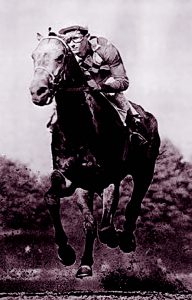 being sidelined for more than three months by bucked shins. He returned to competition at Saratoga with two and a quarter length victory in the Flash Stakes. That was the first of four victories in as many weeks that August. In the Saratoga special, Native Dancer rallied over the sloppy track to win by three and a half lengths and he carried 126 pounds, highest impost of his juvenile season, to a three and a half-length win in the Grand Union Hotel Stakes. The month ended with a two-length win in the Hopeful Stakes. Following a three-week hiatus from racing, Native Dancer won an allowance before facing his toughest competition to date in the Futurity Stakes. Blocked early before running down Tahitian King, Native Dancer posted a two and a quarter-length victory with a final time of 1:14 2/5, equaling the world record for six and a half furlongs over a straight track. With another Stakes win concluding his undefeated season, Native Dancer was the unanimous champion juvenile male. He set a juvenile earnings record of $230,495 and shared the Horse of the Year title with One Count. He was assigned 130 pounds atop the Experimental Free Handicap.
being sidelined for more than three months by bucked shins. He returned to competition at Saratoga with two and a quarter length victory in the Flash Stakes. That was the first of four victories in as many weeks that August. In the Saratoga special, Native Dancer rallied over the sloppy track to win by three and a half lengths and he carried 126 pounds, highest impost of his juvenile season, to a three and a half-length win in the Grand Union Hotel Stakes. The month ended with a two-length win in the Hopeful Stakes. Following a three-week hiatus from racing, Native Dancer won an allowance before facing his toughest competition to date in the Futurity Stakes. Blocked early before running down Tahitian King, Native Dancer posted a two and a quarter-length victory with a final time of 1:14 2/5, equaling the world record for six and a half furlongs over a straight track. With another Stakes win concluding his undefeated season, Native Dancer was the unanimous champion juvenile male. He set a juvenile earnings record of $230,495 and shared the Horse of the Year title with One Count. He was assigned 130 pounds atop the Experimental Free Handicap.
After wintering in California, Native Dancer returned to action on April 18, 1953. Following a two-length triumph in a division of the Gotham Stakes, Native Dancer extended his unbeaten record to eleven when he took the Wood Memorial one week later. That set the stage for his unforgettable Kentucky Derby.
The sight of the 16.2-hand, 1,200-pound, Native Dancer on the Newsreels rally to win America’s top races captivated both racing and non-racing fans. The extent to which the public responded to Native Dancer was seen by the reaction to his lone career loss. The New York Times wrote, “There hadn’t been so much furor over a horse losing a race since Man o’ War defeat by Upset in the Stanford Stakes in 1919.” The setback did not last long as Vanderbilt’s charge won the on-mile Withers Stakes by four lengths. A rematch between the Derby runner-up and Dark Star followed two weeks later, in the Preakness Stakes. Dark Star again took an early lead that he maintained until the stretch, but he faded to finish fifth. A post-race examination determined Dark Star had injured a tendon and he was retired. Native Dancer, meanwhile, was all out to hold off Jamie K for a neck victory. As the 1-5 favourite in the seven-horse field, Native Dancer generated a minus show pool of $46,012, one of the then largest in racing history.
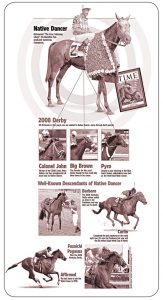 With Dark Star retired, Native Dancer assumed leadership of his division with a neck win over Jamie K in the Belmont Stakes as the 2-5 favourite. The colt’s final time of 2:28 3/5 for one and a half miles was the third best time at that point in Belmont history. In his fourth straight triumph after the Derby, Native Dancer was sent off at 1-20 to win the Dwyer Stakes at Aqueduct. Shipped to the Midwest for the Arlington Classic, the colt was a runaway nine-length winner, then returned to New York to post a five and a half-length romp in the Travers Stakes. With Guerin suspended, Eddie Arcaro, who had ridden Jamie K. in the Derby and Preakness, rode Native Dancer in the American Derby at Washington Park. After the colt rallied from six lengths back nearing the stretch to post a two-length victory under 128 pounds, Arcaro was effusive in his praise of Native Dancer. “Sheer power is the only way to describe him.” A late-season showdown with Tom Fool, the top older horse in the midst of an undefeated campaign, did not materialize after it was discovered that Native Dancer bruised his left forefoot in the American Derby and he was put up for the rest of the year. While Native Dancer was a cinch for three-year-old male championship honours, the Horse of the Year title went to Tom Fool, victorious in all ten of his outings. Native Dancer won his four-year-old debut, an allowance race at Belmont Park. In the Metropolitan Handicap under 130 pounds, Native Dancer unleashed his customary late kick to make up seven lengths, catch leader Straight Face, and win by a neck. The colt was being readied for the Suburban Handicap when soreness was detected in his right foreleg. Rested for three months, Native Dancer made what was to be his final career start when he carried 137 pounds to a nine-length victory in the betless, seven-furlong Oneonta Handicap. Soreness recurred in the right foreleg, and Vanderbilt retired his star.
With Dark Star retired, Native Dancer assumed leadership of his division with a neck win over Jamie K in the Belmont Stakes as the 2-5 favourite. The colt’s final time of 2:28 3/5 for one and a half miles was the third best time at that point in Belmont history. In his fourth straight triumph after the Derby, Native Dancer was sent off at 1-20 to win the Dwyer Stakes at Aqueduct. Shipped to the Midwest for the Arlington Classic, the colt was a runaway nine-length winner, then returned to New York to post a five and a half-length romp in the Travers Stakes. With Guerin suspended, Eddie Arcaro, who had ridden Jamie K. in the Derby and Preakness, rode Native Dancer in the American Derby at Washington Park. After the colt rallied from six lengths back nearing the stretch to post a two-length victory under 128 pounds, Arcaro was effusive in his praise of Native Dancer. “Sheer power is the only way to describe him.” A late-season showdown with Tom Fool, the top older horse in the midst of an undefeated campaign, did not materialize after it was discovered that Native Dancer bruised his left forefoot in the American Derby and he was put up for the rest of the year. While Native Dancer was a cinch for three-year-old male championship honours, the Horse of the Year title went to Tom Fool, victorious in all ten of his outings. Native Dancer won his four-year-old debut, an allowance race at Belmont Park. In the Metropolitan Handicap under 130 pounds, Native Dancer unleashed his customary late kick to make up seven lengths, catch leader Straight Face, and win by a neck. The colt was being readied for the Suburban Handicap when soreness was detected in his right foreleg. Rested for three months, Native Dancer made what was to be his final career start when he carried 137 pounds to a nine-length victory in the betless, seven-furlong Oneonta Handicap. Soreness recurred in the right foreleg, and Vanderbilt retired his star.
Honoured with the Horse of the Year title that eluded him the previous year, Native Dancer retired with just one loss from twenty-two starts and earnings of $785,240. Despite his record, questions remained about Native Dancer’s overall ability since he never faced older horses as a three-year-old and raced only three times after that.
Native Dancer entered stud at Sagamore and left an indelible mark on the breed. The sire of forty-four stakes winners, including 1966 Kentucky Derby winner Kauai King, he is also the grandsire of the great Mr. Prospector and broodmare sire of Northern Dancer. He sired dams of eighty-four stakes winners and linked two of America’s most important sire lines. Son Raise a Native sired Alydar, Exclusive Native (sire of Affirmed), and Majestic Prince (sire of Majestic Light). Native Dancer also sired Atan (sire of Sharpen Up) and Dan Cupid (sire of the great Sea-Bird). Native Dancer died on Nov 16, 1967, of complications from colic.
Extract from ‘Thoroughbred Champions: Top 100 Racehorses of the 20th Century”
Published by Eclipse Press
A Division of Blood-Horse Publications.
To order, go online: www.ExclusivelyEquine.com
OCTOBER-NOVEMBER 2009








